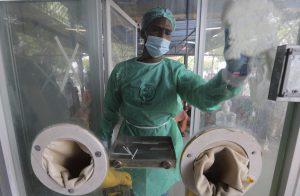In May, Pakistan appeared to be on the edge of a devastating COVID-19 outbreak. The government defied all norms by deciding to lift its lockdown at a time when the country was recording a daily average of over 5,000 cases, with local transmission accounting for at least 90 percent of the spread.
By mid-August, the global COVID tally crossed 23 million, with over 810,000 deaths. Pakistan’s numbers remained relatively low, at around 292,000 infections and over 6,200 deaths in a population of 220.4 million. While the world recorded more than 4 million infections and over 200,000 deaths in the past three weeks, Pakistan contributed around 12,000 cases and less than 250 deaths to that tally.
The government reopened the economy in phases and in doing so achieved the impossible by flattening the curve. But, as the saying goes, things are not always what they seem.
A seroprevalence study, conducted in July by the Health Services Academy (HSA) in collaboration with multiple partners including the Agha Khan University Hospital and World Health Organization, estimated 11 percent of Pakistanis have developed COVID-19 antibodies while 89 percent remain at risk.
“It means that every 10th Pakistani has developed antibodies in their blood against the SARS-Cov-2 virus,” reads the study. People between the age of 20 to 60, current smokers, urban residents, and those who have had contact with a known COVID-19 positive person were found more prone to be exposed to the virus.“There is a very large number out there that needs to be protected from the virus,” said National Command and Operations Center (NCOC) chief Asad Umar.
Epidemiologist Dr. Rana Jawad Asghar interprets the findings to be in line with global studies suggesting 11 to 20 percent of the population in most countries have been exposed to the virus.“The 11 percent could also represent the most vulnerable of the population and the remaining may not be susceptible to the virus,” he added, while expressing doubts over the seroprevalence study’s accuracy.
The scientist-recommended strategy to contain the spread has been lockdowns, testing, and contact tracing. But it is nearly impossible to get a developing country where two-thirds of the population relies on daily wages to stay at home.
“There is a universal acknowledgment that the virus’ spread can be slowed down through behavioral change in the society,” said Umar. “It can be voluntary with the masses informed of the risk and how to save themselves or it can be administratively enforced. We chose to do both.”
He explained Pakistan’s strategy: “Media played an important role in creating awareness, which was backed by our testing, contact tracing, and quarantine program. We managed to increase testing capacity in a very short period and applied a sophisticated tracking system that ran through the ground to apex level.
“At one point, we had over 10,000 contract workers and more than 3,000 contact tracing teams. It became an integral part of our strategy coupled with smart lockdowns in high-risk areas and hotspots and SOP compliance. Those in violation were fined or sealed.”
Despite the SOPs (standard operating procedures) and smart lockdowns, a walk through Karachi’s streets on a midsummer’s evening in mid-July showed business as usual.
“For the first three months, we saw a significant change in behavior. People wore masks and maintained social distancing. Once the cases slowed down, we saw less adherence to the SOPs,” said Umar.
This was followed by Eid-ul Adha celebrations, which also fueled local tourism with thousands driving to the mountains during the holidays. The curve, however, continued on a downward trajectory.
Asghar, the epidemiologist, said he had found the high cases tally and death toll projections for Pakistan incredulous. “Outbreaks don’t behave in such a way,” he explained. “If there is an outbreak in a city, it doesn’t mean every person living in the city will get infected.”
The worst-hit countries have an average age of 35-45 with a high mortality rate in the geriatric population due to the virus’ spread in old-age homes. In contrast, Pakistan has a young population and a social construct that vetoes elderly placements in group homes.
“The youth steps out to work and the population in cities is dense,” reasoned Asghar. “Our social circles aren’t as expansive as those in the West. An ordinary citizen’s social network stays within the bounds of his neighborhood.”
Ashgar believed the high temperature and humidity during summers also helped slow down the spread.What about India, where cases have topped 3 million? “Their testing capacity is way ahead of ours,” he interjects. He pointed out that social stigma around the virus and the fear of government intervention had prevented many families from getting tested.
One theory for Pakistan’s luck suggests the majority of the country’s cases are mild due to locals having high tolerance and a strong immune system. Asghar, however, disagrees. “Pakistan may have fewer cases but its mortality rate (2.13 percent) is higher than India’s (1.8 percent),” he noted, adding that the infection rate depends on multiple factors such as the host body and environment.
WHO COVID-19 technical lead Dr. Maria Van Kerkhove says it is dangerous to compare crude fatality rates across countries. “Some of it has to do with the infected people. In South Korea, particularly in the beginning, many of the people infected were quite young, [and] therefore didn’t have as many underlying conditions that could progress to severe disease or death.”
Recently, speculation around genome mutations increased when South Korea identified a genetically mutated coronavirus from a case imported from Pakistan.
“A change in DG41G mutation was first identified in February. This is a predominant strain in Europe, North America, and it has come back into Asia again,” explained Kerkhove. “More than 75,000 full genome sequences are available publicly and globally from countries all over the world.”
She added that a WHO-constituted research group is looking at each of the changes and mutations to see which are important. “It isn’t just to identify a change but to see whether it means the virus could potentially behave differently.”
Notably, the HSA study strikes down the possibility of herd immunity in Pakistan. “The classic requirement is for 70 percent of the population to develop antibodies either through exposure or vaccination,” explained Asghar.
Whether the COVID-19 antibodies can prevent reinfection is also a puzzle waiting to be solved. “The science is not clear on how long this immunity will last or effective it will be,” Umar said.
Prepared, Unprepared: What’s Next?
Although the seroprevalence study deems reopening schools a risk due to the low seropositivity rate in children under 10 years of age, the government is adamant students must return to classrooms.
“Tremendous amount of efforts have gone into it. Experts have been mobilized to develop training programs for both teachers and students,” said Umar. “But we will continue to optimize until the very day school starts.”
Recalling Iran’s second spike in infections, Umar said the government is very much aware of the risk and plans vigorous monitory to prevent a surge. “If it does happen, we are adequately prepared for it,” he added.
Asghar, however, argued the government needs to expand disease surveillance systems to detect clusters and contain outbreaks on district levels. “When you rely on hospital and lab data, you discover an outbreak three or four weeks after it has occurred. It is too late.”
He recommended the government have field epidemiologists conduct tests and contact tracing. “Results should be available within 24 hours to ensure the patient does not have a chance to infect more people. If our test results come back after days with no contact tracing then we are just wasting time and resources.”
“One Big Wave”
Technically, the first wave needs to end for the second to begin. While some countries, such as China and Germany have managed to bring down the number of infections, others like the United States, India, and Brazil are still struggling to control the spread.
Meanwhile, countries that flattened the curve and began relaxing restrictions are seeing a surge in infections.
But the WHO has maintained that the coronavirus is unfolding in one big global wave with no evidence that a change in season has an effect over its spread. It has also predicted the pandemic will go on for a long time.For a country with a frail healthcare system, a prolonged pandemic may prove to be catastrophic – specially with 89 percent of its population at risk.
10 home remedies to avoid swine flu
15-02-2015
Are the rising swine flu casualties giving you jitters?
Read moreNow just pop a pill to stop blood clots
18-08-2009
Blood clots, which are responsible foir killing many people every year, can now be treated without needles, i.e by oral medication.
Read moreHysterectomy through belly button leaves…
17-08-2009
Doctors have operated on a woman which they claim is the first hysterectomy in Europe through a tiny incision in her belly button, leaving no visible outward scars.
Read moreKissing can cause herpes
17-08-2009
The Australian Herpes Management Forum says that once you are affected with the Herpes virus, it stays in the body and can reactivate at any time.
Read moreA sweeter broccoli to cut heart diseases
17-08-2009
Scientists claimed to have developed a new variety of broccoli that is not only grown naturally, but also tastes sweeter and has 40% more anti-oxidants than the normal to reduce...
Read more'Havan' for bacteria-free homes: Study
16-08-2009
Want to lead a healthy life and free your home from bacteria? Perform 'havan' at regular intervals.
Read moreA cot mattress that mimics the womb
16-08-2009
It's a dream come true for tired-out-moms, a revolutionary new cot mattress which mimics the sensation of the womb to keep babies happy at night.
Read moreIndia should trains its doctors in infec…
16-08-2009
With India battling swine flu, an eminent Indian-American doctor has said it is the right time the government in the country accelerate process of training its doctors in infectious diseases...
Read moreCadila to apply for clinical trials for …
11-08-2009
Cadila Pharmaceutical will seek the govt's nod in two days for initiating clinical trials for a vaccine against swine flu.
Read moreSynthetic bedding 'can cause asthma'
11-08-2009
A new study has claimed synthetic bedding can aggravate asthma more than feather products as it contains high levels of fungal cells.
Read moreNew wave of Swine flu could sicken milli…
10-08-2009
As countries grapple with the Swine flu, experts have warned that a new wave of the deadly virus is ready and could sicken millions.
Read moreNow, an HIV blocking gel for women
10-08-2009
Scientists have developed a "molecular condom", which they claim is a vaginal gel to help protect women from contracting HIV during sexual intercourse.
Read moreHomeopathy can cure swine flu, claims pr…
09-08-2009
At a time the country is grappling with H1N1 virus and Tamiflu tablet is belived to be the only solution, a well-known medical practitioner today claimed that people can have...
Read moreBreast cancer cases surge as cervical di…
05-08-2009
Fewer women in India now suffer from cervical cancer - counted among the worst of killers. However, breast cancer cases have shot up alarmingly.
Read moreWhy dentures? Grow new teeth
04-08-2009
Scientists in Japan have managed to grow teeth from stem cells, a development that could make dentures redundant.
Read moreMen who do household chores more likely …
04-08-2009
According to University of Oxford, Men who do household chores are more likely to marry a girl of their choice.
Read moreOTC EC and abortion pills cause menstrua…
03-08-2009
Gynaecologists have noticed a sharp spike in cases of menstrual complications among young women who are repeatedly using OTC EC and abortion pills.
Read moreUV radiation blinding rural folk, finds …
01-08-2009
Why is every alternate person in rural India above the age of 40 blinded by cataract when only one in five in cities has the disease?
Read more70m diabetics in India by 2015: Study
29-07-2009
India is heading towards a diabetic explosion with 70 million people to be affected by 2015, a decade ahead of expectations.
Read moreTexting while driving increases risk of …
28-07-2009
Don't text while driving as a new study suggests that doing so increases the risk of a crash much more than talking or listening on a mobile phone.
Read more








































